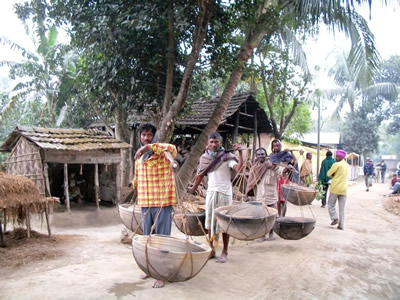Asharikandi craft village
Asharikandi craft village
A small cluster where male and female, young and old of altogether eighty families are always busy to shape and create a range of fascinating terracotta and pottery items is Asharikandi craft village under Devitola Development Block of Dhubri district of Assam.
 An object of art made of a composition of clay and sand and baked with earthen color, a brownish red, is Terracotta. Terracotta is one of the oldest crafts that human beings ever introduced on this earth. It was once considered to be the poor men's craft. But in course of time, it has made its access and occupied a distinct identity among all classes of people by its aesthetic value.
An object of art made of a composition of clay and sand and baked with earthen color, a brownish red, is Terracotta. Terracotta is one of the oldest crafts that human beings ever introduced on this earth. It was once considered to be the poor men's craft. But in course of time, it has made its access and occupied a distinct identity among all classes of people by its aesthetic value.
In India, the single largest cluster where both Terracotta and Pottery crafts are found and practiced in traditional way is Asharikandi (Madaikhali) craft village. Due to the factors of production, the product-quality of one place varies from that of another. Weather is a key factor and plays a major role in Terracotta-production. The main raw material for pottery and terracotta craft is Hiramati, a special type of soil. The quality of Hiramati varies from place to place. The quality of Hiramati and artistic skill determine the quality of Terracotta and Pottery products.
Artistic skill, quality of Hiramati, climatic condition and age-old tradition of Kumbhakaras (potters) of Asharikandi, has enabled to retain a separate identity of Asharikandi- style of Terracotta. HATIMA doll, nationally and internationally acclaimed unique masterpiece of late Sarala Bala Devi, has brought much repute for Asharikandi- style of Terracotta.
The connection with the river Brahmaputra through the Gadadhar, a tributary of mighty Brahmaputra, gives the place an advantage for marketing network with the major cities. Earlier, the needs of the Jamindar (Royal) family for ware and utensils of everyday-use were catered from this area since this potter-community migrated to this place.
Terracotta and pottery work is now their main profession; few years back it was their part- time job. Earlier they used to sell their products like - pitchers and other utensils in the nearby towns and villages, and terracotta products- like Hatima Doll, Ainar Horse, Elephant, Rhino, and other idols of God and Goddesses on the occasions of local festivals and fairs. Now they go out for selling their terracotta products on the occasions like trade fair, and sale cum exhibitions organized by the various Govt. Departments and NGOs. Resellers of terracotta and pottery items come to the artisans' cottages and purchase the goods direct from the village. One can roam in and around the cluster, visit the artisans' cottages full of traditional products, have a glimpse of making of Terracotta, and can also buy them.The selling part of the products is also run by the Scheduled Caste fisherman Barman community people, who are also the residents of Asharikandi village and five hundred families in number. This fishing community, due to the lacking of fishing opportunities, had to leave their ancestral-work and has been shifting to terracotta and pottery trade.
Source : Dhubri district administration
Last Modified : 9/14/2023
Provides information about Indian Handicrafts Port...
Provides information about the National Crafts Mus...
Provides information about eSARAS portal for handi...
